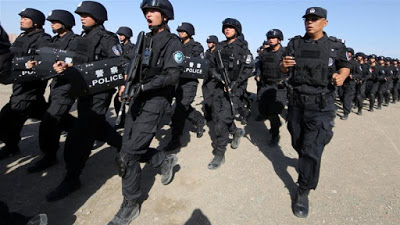On China’s Muslim crackdown
 |
| Richard Javad Heydarian 17 Aug 2018 |
Amid President Xi Jinping’s consolidation of power in China, there are growing concerns over an ongoing crackdown on religious freedoms and basic rights of minority groups in the country.
China has reportedly embarked on an aggressive “Sinification” campaign to recast various “foreign” religions to reflect the regime’s priorities and the country’s unique culture. Abrahamic faiths originating from the Middle East have been the main target of this new policy, which has provoked massive backlash among various ethnic-religious groups.
In particular, the large Muslim Chinese community has resisted coercive “re-education” efforts by the authorities, which have progressively restricted religious minorities from observing the basic articles of their faith. According to a report submitted to the United Nations,as many as one million Uighurs from the western region of Xinjiang may have been forced into internment camps.
Some rights groups are accusing China of engaging in an all campaign of ethnic cleansing. The Chinese authorities, however, have vehemently denied such claims as baseless “defamatory rumors”. Beijing claims that they are only trying to prevent the emergence of “China’s Syria” or “China’s Libya” in Muslim-majority provinces through an iron-fist of decisive security measures.
Yet, ongoing efforts at Sinification of Islam will likely only intensify deep ethnic-religious faultlines in modern China. What’s at stake is no less than the internal coherence in Asia’s most powerful civilisation-state.
The Mirage of harmony
In popular imagination, China is often synonymous with authoritarian tranquility. After all, modern China seems like a bastion of stability, where a communist state has, quite paradoxically, overseen the world’s most successful model of capitalist expansion.
Within less than a generation, the Asian nation has gone from an economic backwater to a global superpower. It has lifted hundreds of millions of its citizens from extreme poverty, while investing hundreds of billions of dollars across the world.
Surveys have consistently shown that majority of the population is satisfied with the ruling communist party’s performance. Yet, a more careful look reveals intensified socioeconomic fault lines, with religious freedom emerging as a key area of contestation in China.
Over the past decade, there has been an upsurge of resistance, sometimes even armed and violent, against Beijing’s marginalisation of the Muslim minority groups. The large-scale migration of Han (mainstream Chinese ethnic group) population into previously Muslim-majority regions as well as government restrictions on observance of basic tenets of Islam, including wearing of veil and fasting during Ramadan, has deepened Uighur grievance against the regime.
In mid-2009, a series of violent clashes between Uighurs and Han residents of Urumqi led to the death and injury of as many as 184 individuals. The radicalised atmosphere has strengthened the hands of groups such as the East Turkestan Islamic Movement (ETIM), which has called for armed resistance against Beijing.
In 2013, terror hit the capital, when several Uighurs, using an SUV, ploughed throughvisitors at Beijing’s Tiananmen Square. The following year saw several terrorist attacks across Xinjiang, one of which claimed the lives of close to hundred individuals as well as an Imam perceived to be regime-friendly.
That year also saw a group of suspected Uighur extremists chasing and assaulting civilians in Kunming, in the province of Yunan, with knives, provoking fears of widespread terror attacks across the country.
Iron-Fist response
In response, the communist regime, which derives its legitimacy from bringing about order and prosperity, adopted increasingly draconian measures, reportedly including the establishment of “reeducation camps” for religious recantation, to crash resistance among ethnic minority groups and prevent terror attacks across the country.
In a particularly strident editorial, The Global Times, a hard line Chinese government mouthpiece, portrayed the ongoing crackdown on and cultural marginalisation of Uighurs as a justifiable policy to ensure “Xinjiang has been salvaged from the verge of massive turmoil” and “evil influence” of extremism.
It accused critics, particularly in the West, of trying to “stir trouble for Xinjiang and destroy the hard-earned stability in the region.” The newspaper claimed that the Chines government has brought “rule of law and ethnic unity” in the troubled province.
Echoing the standard argument of the communist regime, the editorial argued that “[p]eace and stability must come above all else”, even if this means the adoption of “all [necessary] measures”.
Recent weeks saw the extension of the government’s religious crackdown to the historically well-integrated Hui Muslims in northern Ningxia region, reflecting a more aggressive attempt at Sinification of religion. A recent government decision to demolish the Weizhou Grand Mosque, supposedly for lack of proper permit but likely because of its more Middle Eastern design, sparked days of massive protests by thousands of Hui Muslims.
China’s relations with Muslim-majority Central Asian neighbours have also come under strain. Recently, a Kazakh court ruled in favour of Sayragul Sauytbay, an ethnic Kazakh Chinese national, who sought refuge in the central Asian country after exposing the presence of internment “reeducation” camps for Muslim minority groups. China sought her extradition for supposedly violating state secrets, an accusation that can carry death penalty.
Her case sparked widespread outrage against China across Kazakhstan, forcing the Beijing-friendly government to protect the asylum-seeking activist. Unless the Chinese communist regime reconsiders its current policy towards religious minority groups, it will likely inspire even greater resistance among Muslim groups at home and backlash among neighbouring Muslim countries.
The views expressed in this article are the author’s own and do not necessarily reflect Al Jazeera’s editorial stance.


